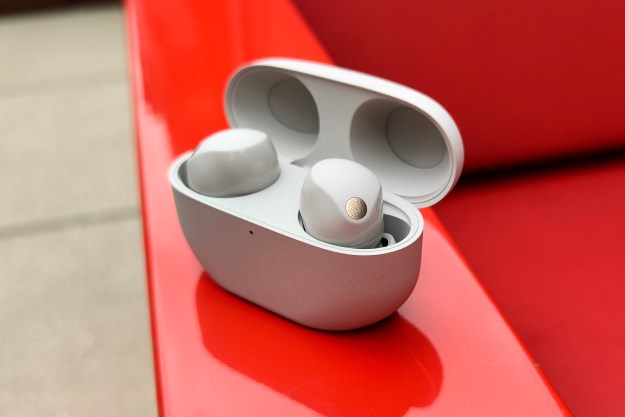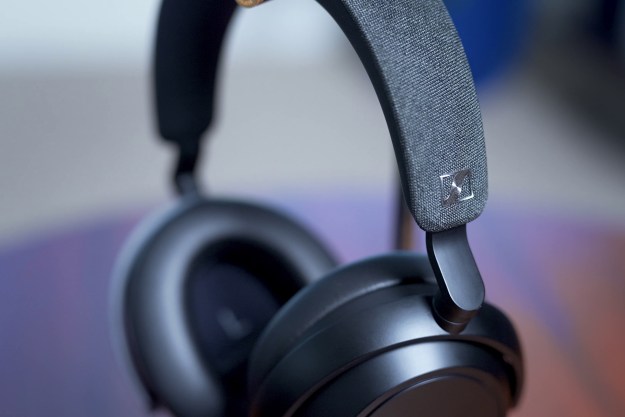“Overall, the Sennheiser HD580s perform superbly, and produce absolutely beautiful, balanced, and spatial sound.”
- Audiophile quality sound
- extremely comfortable
- open design great for LAN parties.
- Requires an amp to fully enjoy
- not suitable for portable players.
Summary
If you want absolutely crystal clear, comfortable, and moderately priced headphones for music and gaming, seriously consider the Sennheiser HD580s. Many audiophile quality stores will have generous return and exchange policies, so be sure to give them a try if you have any doubts. While they can be driven by portable players, the HD580s are meant for slightly more powerful and cleaner sources. Many owners will swear by the performance boost of adding an amp, which comes at an additional cost that can range from $100 to several thousand, but most soundcards and stereos should be able to put out enough power to overcome any volume limitations seen on portable players. Overall, the Sennheiser HD580s perform superbly, and produce absolutely beautiful, balanced, and spatial sound.
Forward
Before saying a word about how amazing the Sennheiser HD580s are, two issues must first be addressed.
First, there appears to be a divide in the audiophile headphone community with many people falling into either the Sennheiser or Grado side. Both manufacturer high quality headphones with unique characteristics and this review is not meant to be a comparison or ranking of the HD580s in comparison to other offerings. It is a standalone, hands on review discussing the use of the headphones in the situations below. Your taste may vary.
Second, this review assumes the intended use is for PC use. As such, there is no amplifier, which may sound like heresy to audiophiles. Perhaps later, we will add a review with amp performance. That having been said, the Sennheiser HD580s are not for use with portable devices, which will drive them to decent levels, but to really get volume and added clarity, you’ll need to boost them.
Introduction
The Sennheiser HD580’s are the slightly cheaper version of the flagship HD600 headphones. The primary difference between the two is the material making up the housing and the grill. The HD580s use plastic, while the HD600s use carbon fiber and stainless steel. There are also the HD570 and HD590, which are not as similar to the HD600.
One thing stands out about the Sennheiser HD580s, besides sound quality, is comfort. The ear pads apply very little pressure, the material is soft, and they do not slip. The cord measures 10 feet, which is the source of endless modding by fanatics. Most brick and mortar stores will only carry the HD600s, so online ordering may be your best bet when ordering a pair.
The hardest thing about reviewing the Sennheiser HD580s was actually stopping the music to switch discs. Every sound component is perfectly balanced. No screechy highs, no boomy bass, no flat mids; absolutely wonderful sound. The soundstage feels comfortably wide, but not too wide and close and not ‘in your face’. The open design allows for a lot of leakage, and the outside world is only slightly muffled, if at all. Sound placement is precise. So much so that you could probably close your eyes and point to exactly where the instrument in the orchestra is located within a few feet.
Use and testing
To continue with the previous two reviews (Koss KSC-35, Shure E2C); we used the same selection of music. Bjork’s “Vespertine” (DVD-Audio and MP3), Mahler Symphony 10 (Berliner Philharmoniker – conducted by Sir Simon Rattle – DVD-Audio), The Cure’s “Disintegration” (Audio CD + MP3), Gary Numan’s “Exile” (CD and MP3), and Delirium’s “Karma” (CD and MP3) from a SoundBlaster Audigy 2 Platinum (for DVD-Audio, CD, and MP3), iRiver SlimX 350 (CD and MP3), and Rio PSA|Play 120 (MP3). All MP3s encoded with VBR 160kbps-300 kbps/44kHz.
Delirium sounded beautiful. Spatial during instrumental/chanting, localized during vocals. Excessive use of fading made for a nice test of the HD580’s smoothness in amplitude adjustments and treble. Gary Numan used more diffused sound, panning, and pushed the quality of the bass frequency response. Again, no problems at all in the bass quality, and movements were so fluid it was dizzying. The Cure did not sound as warm as we would have liked. The more relaxed sound of the HD580s lacked impact during the punchy moments, smoothing the overall sound when not entirely appropriate. Where the HD580s really shined was during Mahler. If you aren’t a classical music fan before you buy a pair, you will be afterwards. Localization of sound was simply perfect, as was overall sound quality. After a brief audition, one could say with a good degree of confidence that they didn’t like the third violinist from the left in the back row. Bjork performed very well, following all odd little fluctuations in her voice, even when overlaying deep bass lines. After auditioning several headphones, there were distinctly new sounds in the background that were simply unnoticeable on other
An added bonus to the HD580s is their gaming performance. While the bass lacked the impact of some headphones, the comfort, openness, and great localization abilities made for great gaming. Quake 3, Tribes 2, and Jedi Knight 2 all performed well. There is actually very little to say on their gaming performance. It isn’t a coincidence that the Sennheiser HD580s are an option on Alienware Gaming Systems. If you want to feel like you’re in the game, but still hear LAN players or the phone ring, you can’t go wrong with the HD580s.
Conclusion
If you want absolutely crystal clear, comfortable, and moderately priced headphones for music and gaming, seriously consider the Sennheiser HD580s. Many audiophile quality stores will have generous return and exchange policies, so be sure to give them a try if you have any doubts. While they can be driven by portable players, the HD580s are meant for slightly more powerful and cleaner sources. Many owners will swear by the performance boost of adding an amp, which comes at an additional cost that can range from $100 to several thousand, but most soundcards and stereos should be able to put out enough power to overcome any volume limitations seen on portable players. Overall, the Sennheiser HD580s perform superbly, and produce absolutely beautiful, balanced, and spatial sound.
Editors' Recommendations
- Best headphone deals: AirPods, Sony, Sennheiser and more
- Sennheiser Accentum Plus aims at the middle ground between budget and baller
- What is 4K? Everything you need to know about 4K Ultra HD
- Sennheiser’s new budget-friendly headphones get a very high-end feature
- Sennheiser’s Ambeo Soundbar Mini is a pricey, bedroom-sized Dolby Atmos speaker





